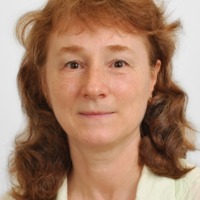Papers by abderazzak taime
Lecture notes in electrical engineering, 2016
Many applications in the field of computer graphics are becoming more complex and require more ac... more Many applications in the field of computer graphics are becoming more complex and require more accurate simplification of the surface meshes. This need is due to reasons of rendering speed, the capacity the backup and the transmission speed 3D models over networks. We presented four basic methods for simplifying meshes that are proposed in recent years. The result obtained by the implementation of these methods will be the subject of a comparative study. This study aims to evaluate these methods in terms of preserving the topology and speed.
Multimedia Tools and Applications, Mar 29, 2018
This paper introduces a new mesh segmentation approach into semantic parts, most closely resemble... more This paper introduces a new mesh segmentation approach into semantic parts, most closely resemble those made by humans, which is based on the pixel color of the images used in the 3D reconstruction. This approach allows to segment the mesh into semantic and a much simpler way than most of the mesh segmentation methods that are based on the geometrical characteristics of the mesh. The principle of our method is to establish a link between the color objects of the scene and the mesh while exploiting the link between the interest points of the images brought into play and the vertices of 3D mesh. The results in great part, reflect the efficiency and performance of our method.

Multimedia Tools and Applications, Jun 5, 2018
Point matching via corresponding circles (ICC) is a technique for removing outliers (mismatches) ... more Point matching via corresponding circles (ICC) is a technique for removing outliers (mismatches) from given putative point correspondences in image pairs. It can be used as a basis for a wide range of applications including structure-from-motion, 3D reconstruction, tracking, image retrieval, registration, and object recognition. In this paper, we propose a new method called Fast Identification of point correspondences by Corresponding Circles (FICC) that improves the quality of the rejection mismatches and reduces the cost of computing it. In particular, we propose a new strategy that aims to take better advantage of the corresponding circles and reduces the number of putative points correspondences tested by the corresponding circles in each iteration rather than all set of putative correspondences, as in the original ICC. This reduces the computing time and together with a more efficient tool for rejecting mismatches which leads to significant gains in efficiency. We provide comparative results illustrating the improvements obtained by FICC over ICC, and we compare with many state-of-the-art methods.

Radioelectronic and Computer Systems
The subject matter of the article is the improvement in the accuracy of multimodal image registra... more The subject matter of the article is the improvement in the accuracy of multimodal image registration between PET and MRI images in the medical field. The focus of the article pertains to the importance of these images in diagnosis, interpretation, and surgical intervention. This study increased the accuracy of PET/MRI multimodal image registration achieved through a new approach based on the multi-resolution image decomposition. The tasks to be solved are: The study proposes a new method, the fast and adaptive three-dimensional mode decomposition (FATEMD), to generate multi-resolution components for accurate registration. The method used: The study uses the FATEMD approach, which estimates the transformation parameters of the registration from the PET image and the residue of the second level of the MRI image that is obtained after the extraction of the first two tridimensional intrinsic mode functions (TIMFs). The following results were obtained: The proposed method of multimodal ...
2019 International Conference on Intelligent Systems and Advanced Computing Sciences (ISACS), 2019
We present a simple method for constructing patterns of Islamic geometric art. The method allows ... more We present a simple method for constructing patterns of Islamic geometric art. The method allows creating a parameterized set of motifs within a fundamental region of a periodic pattern. The constructed template motif will undergo the inner symmetries of a chosen symmetry group to obtain the content of the unit cell. The whole pattern is obtained by applying several linearly independent translations to the generated unit motif. We show how this method can be adapted to construct Islamic quasi-periodic patterns.
2019 International Conference on Intelligent Systems and Advanced Computing Sciences (ISACS), 2019
We propose an algorithm for elimination of false correspondences from given putative point corres... more We propose an algorithm for elimination of false correspondences from given putative point correspondences in couples of stereoscopic images based on corresponding circles (ICC) technique. In this paper, we propose a new method that reduces the cost of computing false correspondences. The aim of this method is mainly to take better advantage of the corresponding circles. The quantitative results demonstrate the efficiency and performance of our algorithm.

Multimedia Tools and Applications, 2018
Point matching via corresponding circles (ICC) is a technique for removing outliers (mismatches) ... more Point matching via corresponding circles (ICC) is a technique for removing outliers (mismatches) from given putative point correspondences in image pairs. It can be used as a basis for a wide range of applications including structure-from-motion, 3D reconstruction, tracking, image retrieval, registration, and object recognition. In this paper, we propose a new method called Fast Identification of point correspondences by Corresponding Circles (FICC) that improves the quality of the rejection mismatches and reduces the cost of computing it. In particular, we propose a new strategy that aims to take better advantage of the corresponding circles and reduces the number of putative points correspondences tested by the corresponding circles in each iteration rather than all set of putative correspondences, as in the original ICC. This reduces the computing time and together with a more efficient tool for rejecting mismatches which leads to significant gains in efficiency. We provide comparative results illustrating the improvements obtained by FICC over ICC, and we compare with many state-of-the-art methods.

Multimedia Tools and Applications, 2017
The matching points extracted from images play a very important role in many applications and par... more The matching points extracted from images play a very important role in many applications and particularly in computer vision. The use of point sets as being characteristics that describe the entire images brought into play, it greatly contributes to the reduction of the execution time, unlike the use of all the information contained in these images. The major problem of the matching process is the possibility to generate a large number of false correspondences, or outliers, in addition to a limited number of true correspondences (inliers). The objective of this paper is to propose a robust algorithm to eliminate or reduce the false correspondences, or outliers, among the putative set extracted from stereoscopic images. The principle of our method is based on the notion of belonging to the corresponding circles and the concept of similarity of stereoscopic images. The results largely reflect the efficiency and performance of our algorithm in comparison to the other used methods in this framework like RANSAC algorithm.
Lecture Notes in Electrical Engineering, 2016
Many applications in the field of computer graphics are becoming more complex and require more ac... more Many applications in the field of computer graphics are becoming more complex and require more accurate simplification of the surface meshes. This need is due to reasons of rendering speed, the capacity the backup and the transmission speed 3D models over networks. We presented four basic methods for simplifying meshes that are proposed in recent years. The result obtained by the implementation of these methods will be the subject of a comparative study. This study aims to evaluate these methods in terms of preserving the topology and speed.
Multimedia Tools and Applications, 2018
This paper introduces a new mesh segmentation approach into semantic parts, most closely resemble... more This paper introduces a new mesh segmentation approach into semantic parts, most closely resemble those made by humans, which is based on the pixel color of the images used in the 3D reconstruction. This approach allows to segment the mesh into semantic and a much simpler way than most of the mesh segmentation methods that are based on the geometrical characteristics of the mesh. The principle of our method is to establish a link between the color objects of the scene and the mesh while exploiting the link between the interest points of the images brought into play and the vertices of 3D mesh. The results in great part, reflect the efficiency and performance of our method.











Uploads
Papers by abderazzak taime